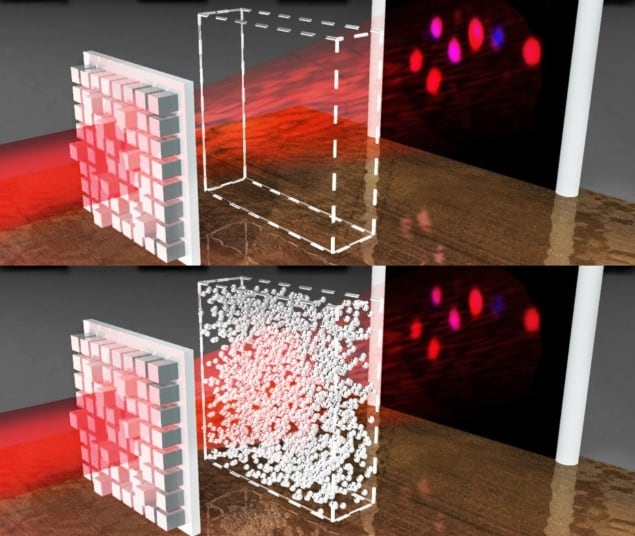
Scientists in Europe have experimentally created a new class of light waves that can pass through opaque materials as if they were not there. These “scattering-invariant modes of light” create the same light pattern whether they travel through a complex scattering structure or a homogenous medium, such as air. According to the researchers, the mathematical formula used to calculate the optimal waveform for the disordered environment could also be applied to other types of waves, such as acoustics.
Physicists Stefan Rotter, at TU Wien in Austria, and Allard Mosk, at Utrecht University in the Netherlands, are developing mathematical methods to describe the light scattering effects of disordered systems. Their analysis shows them how the disordered medium affects the light. This allows them to then create a wave pattern that is affected in a predictable way by the material, for example, by being scattered in a way that they expect.
Such insights could enable scientists to better control how light travels through complex scattering environments, with implications for various applications, particularly imaging. Recently, Rotter and Mosk demonstrated how the scattering of laser light through such a disordered system can be controlled to allow accurate measurements of objects hidden behind it.
In their latest research, the researchers “show how you can construct a light wave that goes through a medium in such a way that the wave is identical to the one you would get if the medium wasn’t there,” Rotter tells Physics World. These light waves “propagate through complicated medium and are transmitted in such a way that the output pattern is the same as the output pattern you would get if the object wasn’t there,” he explains.
To do this, the researchers first had to characterize the scattering medium precisely. At Utrecht University, they shone light through a layer of zinc oxide nanopowder deposited on a glass slide. They then used a detector on the other side to measure the light and analyse how it had been scattered by the powder. Once this has been done, Rotter explains, you can calculate “what kind of wave would be transmitted through this medium in the same way as through fresh space”.
Doing this, the researchers identified the scattering-invariant modes of light. They then demonstrated that they could successfully generate these light waves experimentally by sending a laser beam onto a spatial light modulator.
In a series of experiments, the researchers shone scattering-invariant modes of light in patterns shaped to resemble the stellar constellations of Ursa Minor and Ursa Major through a 5 μm-thick layer of zinc oxide powder and through air. They found that the patterns produced by the light travelling through the zinc oxide and through air were very similar, although the light that had propagated through the zinc oxide was attenuated slightly.
In principle, these scattering-invariant modes can be created for any type of wave, including visible light and sound waves, Rotter tells Physics World.
Rotter says that as well as it being interesting that such waves can be created, they could also help improve imaging through complex scattering media, including in biomedical applications. Essentially, this technique could be used to introduce light further into scattering environments such as the human body than currently possible. Rotter cautions, however, there are challenges with this. Patients move, they breathe and blood flows through their bodies, meaning the medium is constantly changing, making it hard to precisely characterize the scattering effect on light.
The researchers report their findings in Nature Photonics.
"light" - Google News
May 04, 2021 at 05:13PM
https://ift.tt/3gWCMdn
Indestructible light waves travel through opaque material as if it isn't there – Physics World - physicsworld.com
"light" - Google News
https://ift.tt/2Wm8QLw
https://ift.tt/2Stbv5k
Bagikan Berita Ini















0 Response to "Indestructible light waves travel through opaque material as if it isn't there – Physics World - physicsworld.com"
Post a Comment